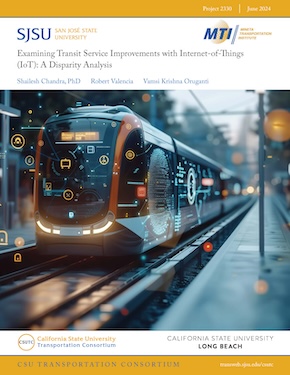- 408-924-7560
- mineta-institute@sjsu.edu
- Donate
Examining Transit Service Improvements with Internet-of-Things (IoT): A Disparity Analysis
Literature shows that poor service reliability of transit often leads to uncertain waiting times at transit stations, diminishing their popularity and usage, and this particularly affects low-income populations more likely to rely heavily on transit. This research delves into an in-depth analysis of the inequality assessment of the Los Angeles (LA) Metro Rail lines, with a particular focus on evaluating the potential impacts of integrating Internet of Things (IoT) technology. This study investigates how IoT could influence service connectivity, accessibility, and the existing disparities in transit services. The primary goal of this study is to assess how the implementation of IoT technology could enhance the connectivity and accessibility of LA Metro Rail services, and whether such technological advancements could contribute to mitigating service inequality. The research methodology encompasses a comprehensive analysis of connectivity and accessibility values across all LA Metro Rail lines for the years 2015, 2017, and 2019. This approach allows for evaluating the potential impact of IoT technology on service connectivity and accessibility for inequality. The study considers several factors, including potential ridership based on low-income populations’ proximity to transit stations and the integration process of IoT technologies within the rail service infrastructure. The study reveals that IoT implementation could significantly improve service accessibility across all rail lines, indicating a positive trend in technological advancements enhancing public transit. However, the impact on reducing service inequality is inconsistent. Notably, Rail Line B would experience fluctuating accessibility with IoT, while Rail Line C showed persistent inequality under IoT deployment scenarios. These findings suggest that while IoT could hold promise for enhancing service quality, its effectiveness is subject to a range of influencing factors, scheduled frequency and stops at stations for the transit rail lines as well as the presence of low-income populations near these stations.
SHAILESH CHANDRA, PHD
Dr. Chandra is an associate professor in the Department of Civil Engineering and Construction Engineering Management at California State University, Long Beach (CSULB). He obtained his MS and PhD in civil engineering from Texas A&M University in 2009 and 2012, respectively. Dr. Chandra has more than 16 years of experience in transportation research focused on transport connectivity, transportation economics, accessibility, urban freight, and sustainability. He has been a principal investigator for several projects funded by various transportation agencies including the California Department of Transportation (Caltrans) and the United States Department of Transportation (USDOT).
ROBERT VALENCIA
Mr. Valencia is an undergraduate student in the Department of Civil Engineering and Construction Engineering Management at CSULB. His research interests relate to transportation data analysis, freight transportation and sustainability.
VAMSI KRISHNA ORUGANTI
Mr. Oruganti is a graduate student in the Department of Computer Engineering and Computer Science at CSULB. His research interests relate to programming, data analysis and transportation.
-
Contact Us
San José State University One Washington Square, San Jose, CA 95192 Phone: 408-924-7560 Email: mineta-institute@sjsu.edu






